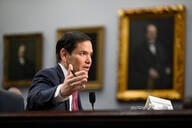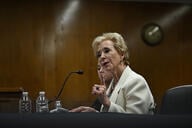You have /5 articles left.
Sign up for a free account or log in.
A prominent (if disputed) criticism of the Occupy Wall Street movement has been its amorphous, platform-free nature. But as the protests that began in New York in September have continued, spreading across the United States and the world, one clear issue of concern has emerged: student loan debt.
On the movement’s unofficial manifesto, the “We Are the 99 Percent” Tumblr blog, young adults hold handwritten signs with their personal stories. More often than not, they include tens of thousands of dollars of debt and, the former students write, little hope for good job opportunities.
“I have $50,000 in student loan debt and my B.A. is useless,” one wrote.
From another: "Graduated college: May 2010. Debt: $35,000. Jobs in US: None.”
Some are resigned: “I am 38 years old. It will take me almost 30 years to pay off my student loans (in 2023).” Others are plaintive: “I am 24 years old and am $90,000 in debt from getting a college education. Why are we being punished with debt for getting a higher education?”
The protests (which New York City authorities are trying to shut down this morning) came at a moment when several trends were already converging, observers say: rising college costs, an increasing emphasis on promoting higher education for low-income students, more borrowing and decreasing numbers of jobs for new graduates.
But while the roots of the outcry over loans may be clear, the long-term repercussions are not. The movement’s focus could be a political flash in the pan, dissipating once the world’s attention turns elsewhere. Or the growing public awareness of student debt could lead to better consumer protections, especially on private loans, or to more responsible borrowing habits.
The anger about student debt could also create difficulties for President Obama, for whom students and young graduates are a key voting bloc, although it's unlikely that federal loans make up the majority of the most problematic debt. Many of the students with the most onerous burdens took out private loans, which had few consumer protections until the recent past. Banks, a key target of the Occupy protesters' ire, also now play a much smaller role in the federal student loan program after changes made in 2009.
Higher education advocates and experts worry there could be one lasting outcome: the protesters’ message of crushing debt and "worthless" degrees could discourage students from borrowing even a reasonable amount in order to get an education.
“You have an unsustainable system,” says Deanne Loonin, a lawyer at the National Consumer Law Center and director of the center's Student Loan Borrower Assistance Project. “All those forces can’t go on forever. You can’t keep the reliance on loans, the accelerating cost of education, the open-door policy. There’s a lot of forces that have been resistant to change. If something’s going to change things, this is it.”
A Growing Outcry
Since the original Occupy Wall Street protest began Sept. 17, student loans have become a rallying point. Occupy DC protested outside the main office of Sallie Mae, the student loan giant, blocking the entrances to the building and posting signs equating student debt with slavery. An Occupy Boston march demonstrated outside Bank of America and the Harvard Club, chanting “Not just for the rich and white, education is a right,” the Associated Press reported.
Student loan debt had been growing for decades without becoming a major public concern. The recession, which has led to a spike in loan default rates and caused many underemployed graduates to feel their degrees were not worth the money, has been a tipping point in public opinion, says Anya Kamenetz, the author of Generation Debt.
“Student loan debt has been rising inexorably, and college students in the last couple of years are entering one of the worst job markets in a generation,” Kamenetz says. “There’s a real feeling of betrayal that hits a lot of people when they find out that the debt they were told was good debt is not paying off.”
Low-income students, college dropouts, or nontraditional students at for-profit colleges have felt for years that they took on debt and received little in return, Loonin says. But the Occupy movement has also drawn more traditional students who borrowed to attend a four-year college. Those students and their parents are wealthier, have more political clout, and are more likely to get attention.
“I think it was sustainable because there were enough rewards for people," Loonin says of increases in borrowing. "It feels like that connection has been broken for a lot more people, and I think it’s that combination that’s leading some of the more traditional students and their families to speak up.”
The Occupy movement has also reinvigorated a two-year crusade for student loan forgiveness that Robert Applebaum, a lawyer, launched in 2009. Applebaum’s proposal called for forgiving all student debt as a means of economic stimulus, and economists panned it: Justin Wolfers, an associate professor of business and public policy at the University of Pennsylvania, wrote on the popular Freakonomics blog that it was the “Worst. Idea. Ever." But Applebaum’s petition eventually gained more than 650,000 signatures, and a version posted to the White House’s “We the People” petition site gathered more than 30,000 and received an official written response.
“We agree that reducing the burden of student loans is an effective way to stimulate the economy and save taxpayer dollars,” Roberto Rodriguez, a special assistant to the president for education policy, wrote.
The response went on to tout the Obama administration’s plan to ease repayment for some borrowers. That plan, announced in October and designed to be implemented without needing permission from Congress, would give a slight interest rate cut to borrowers who consolidate their federal loans and expand income-based repayment. White House officials billed it as a response to Applebaum’s petitions and the growing concern surrounding student debt.
If the focus on loans continues, it could present problems for the White House, which has increased the federal government’s role in student loan programs. Many of the changes pushed by the Obama administration, including the switch away from bank-based lending and the recent expansion of income-based repayment, relate to the Occupy demonstrators' grievances. Some of the government's "profit" from student loans has been redirected toward expanding Pell Grants for low-income students. And private loans fall largely outside the administration's purview.
Still, dissatisfaction among college students and young graduates could pose a formidable problem for the Obama administration because that group was a strong constituency for the president in the 2008 election, says Mark Kantrowitz, publisher of Finaid.org.
“The default rates would have to at least quadruple before the profits to the federal government would disappear,” Kantrowitz says. “The student loan issue is an issue for the Obama administration because it’s the students who elected him. If their issues aren’t addressed, it could affect the next election.”
Criticisms of the student loan program have emerged in the race for the Republican nomination: Texas Rep. Ron Paul called for the program's elimination during a recent debate, and Newt Gingrich called the program an "absurdity." Herman Cain has said the government should get out of the student loan business altogether. (Few Occupy protesters would support a system that relies entirely on private loans, the source of many of their grievances. But federal student loans have historically enjoyed bipartisan support, and the criticism is a strong indicator of their recent unpopularity.)
So far, Applebaum at least is willing to give the president the benefit of the doubt. The administration's proposed loan changes are modest when compared with his call, echoed by many Occupy protesters, to eliminate student debt entirely. “It really doesn’t do much to help anyone,” Applebaum says of the new initiative. "That’s not, in my opinion, because the president doesn’t want to do more. It’s that he can’t do more. There’s only so much he can do on his own.”
Loan Misconceptions
As student debt has become a focus of the Occupy movement, some wonder how it surpassed concerns about financial regulation, income inequality and other societal issues.
While some Occupy protesters report debt levels that would previously have been considered reasonable -- $25,000 or less -- many carry larger amounts. Media reports focus on students with at least $50,000 in debt, and anecdotes of students with more than $90,000 in debt are not uncommon.
Still, borrowers with such catastrophic debt are part of a "1 percent" -- although not the 1 percent that is the movement's target. Students who are in debt for more than $100,000 from an undergraduate degree are make up less than 0.5 percent of all borrowers, says Lauren Asher, president of the Institute for College Access and Success.
“The people who are really protesting are pretty much the people who went to college and don’t have the life they expected to have right after college,” says Sandy Baum, a policy analyst who focuses on financial aid. “You have to sympathize with them, but they are not focused on the greatest of social ills. They’re focused on their circumstances right now.”
Borrowers with more than $40,000 in undergraduate debt likely relied at least in part on private loans, meaning that they are ineligible for income-based repayment and other federal provisions that can ease repayment for borrowers who are facing financial hardships. Congress tightened regulations on private loans in August 2008, requiring more disclosure and information about federal options for prospective borrowers, but students who borrowed privately before that often did not realize how onerous the loans could be until they encountered financial trouble, Asher says.
Because lenders like Sallie Mae often issued both federal and private loans, many borrowers did not even know the difference. While many cite large debt burdens and low incomes, few seem aware of programs like income-based repayment, which allow borrowers whose loan payments exceed a certain percentage of their discretionary income to cap the payments. (The program is available only for students with federal loans, not those who have incurred private debt.)
“It’s highlighted how much more needs to be done to get the word out about income-based repayment and other ways that people can help keep their federal student debt from harming their financial future,” Asher says.
Asher and Baum say they hope the focus on debt has positive results. Future students might borrow more carefully, they said. Or the government could regulate private loans more strictly. But they fear that concerns about borrowing will go too far, and that the stories of unemployed borrowers with six-figure debt will discourage from taking out even relatively safe federal loans to pay for college. Students should be able to borrow up to a conservative estimate of their starting salary after graduation -- say $25,000 or $30,000 -- as long as they are realistic about their ability to make the payments, Baum says.
“There’s a risk that the fear of unmanageable debt will deter people from going to college, or from finishing college, when it’s still the best investment they can make in their future, if they shop around, borrow wisely, and stick to federal loans,” Asher says.
Some of the testimonials indicate that their fears are not unfounded.
“My entire life, I have wanted nothing more than to go to college & make something of myself,” one wrote. “Now that I have read some of the stories, I am afraid to go to school.” Another wrote that he wanted an education but would not enroll even at the local community college, where tuition is low, due to concern about accumulating debt.
For the protesters, higher education is part of a system that many view as rigged against them, says Applebaum, whose push for forgiving student loans has become closely associated with the Occupy movement. "We have finally reached a tipping point for people in America -- they're fed up," he says. "I hear a lot of criticisms about the Occupy protests talking about how it's not coherent, they don't have a lists of specific demands. That's ridiculous to me. They're protesting the whole system. It's the whole system that's rigged against them, and they know it, and they're sick of it."
One protester has formed the EDU Debtors' Union, which she describes as a "labor union" for debtors that would use default as a tactical message to negotiate for better loan terms.
But even the protesters who are concerned about their loans now have better future prospects than people who never went to college, Baum counters. “It’s easy to come up with an anecdote of a person who borrowed a lot of money and is in bad shape,” she says, adding that such people deserve sympathy and help. “We can find people who borrowed $25,000 and went to college and are so grateful they had that money, but putting one of them up there doesn’t have the same impact.”
Applebaum -- along with many of the protesters -- sees it differently. The notion of "good debt" is a lie, he says. "In the last 30 years, we've turned education into a commodity," he says. "We used to fund higher education through a series of grants and scholarships and savings. We've lied to a generation of Americans by telling them it's quote-unquote 'good debt.' We've sold them a bill of goods."
In the meantime, the testimonials on the Tumblr and the protest signs referencing student loans continue to multiply. “I have $90K in student loan debt,” the latest read Wednesday night. “My payments are 20% of my income. By the time I pay off my debt, I will have paid the government double what I borrowed.”




